Essay: Comparing and Contrasting Healthcare Systems in the US
VerifiedAdded on 2022/08/12
|7
|1603
|64
Essay
AI Summary
This essay provides a detailed comparison of three major healthcare delivery systems in the United States: Medicare, Medicaid, and private health insurance. The essay begins with an introduction to the US healthcare system, highlighting the absence of universal coverage and the rising costs of medical care, while also mentioning the Patient Protection and Affordable Care Act (ACA). The paper then delves into descriptions of Medicare, which provides health insurance to older adults and those with disabilities; Medicaid, which serves low-income individuals, children, and people with disabilities; and private health insurance, available through individuals or group plans. The essay discusses the advantages, disadvantages, and philosophies of each system, citing relevant statistics and changes in the healthcare landscape. The essay also examines the impact of the ACA and other factors on the coverage and enrollment in each system, concluding with a call for universal healthcare coverage to improve accessibility to healthcare services.
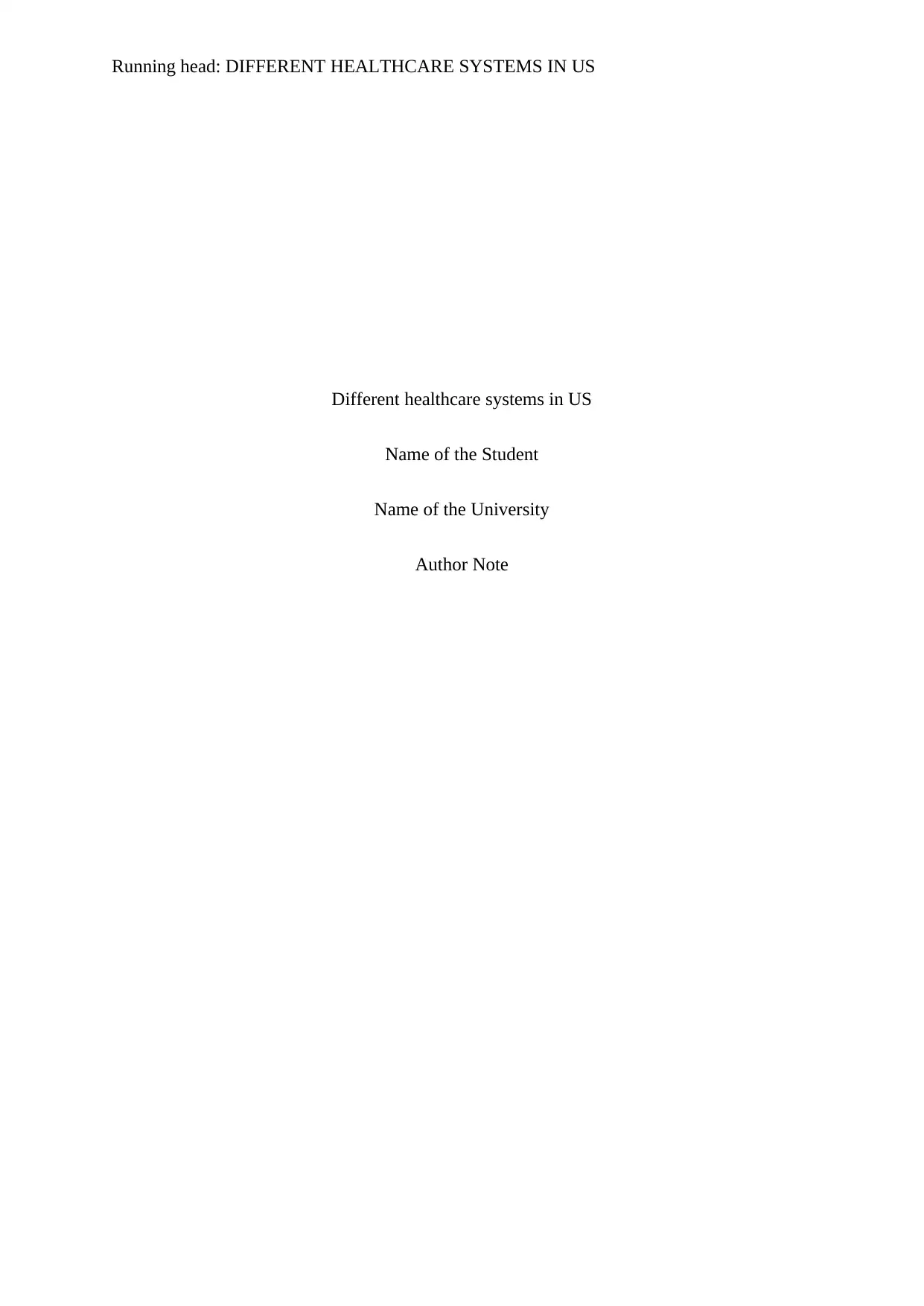
Running head: DIFFERENT HEALTHCARE SYSTEMS IN US
Different healthcare systems in US
Name of the Student
Name of the University
Author Note
Different healthcare systems in US
Name of the Student
Name of the University
Author Note
Paraphrase This Document
Need a fresh take? Get an instant paraphrase of this document with our AI Paraphraser
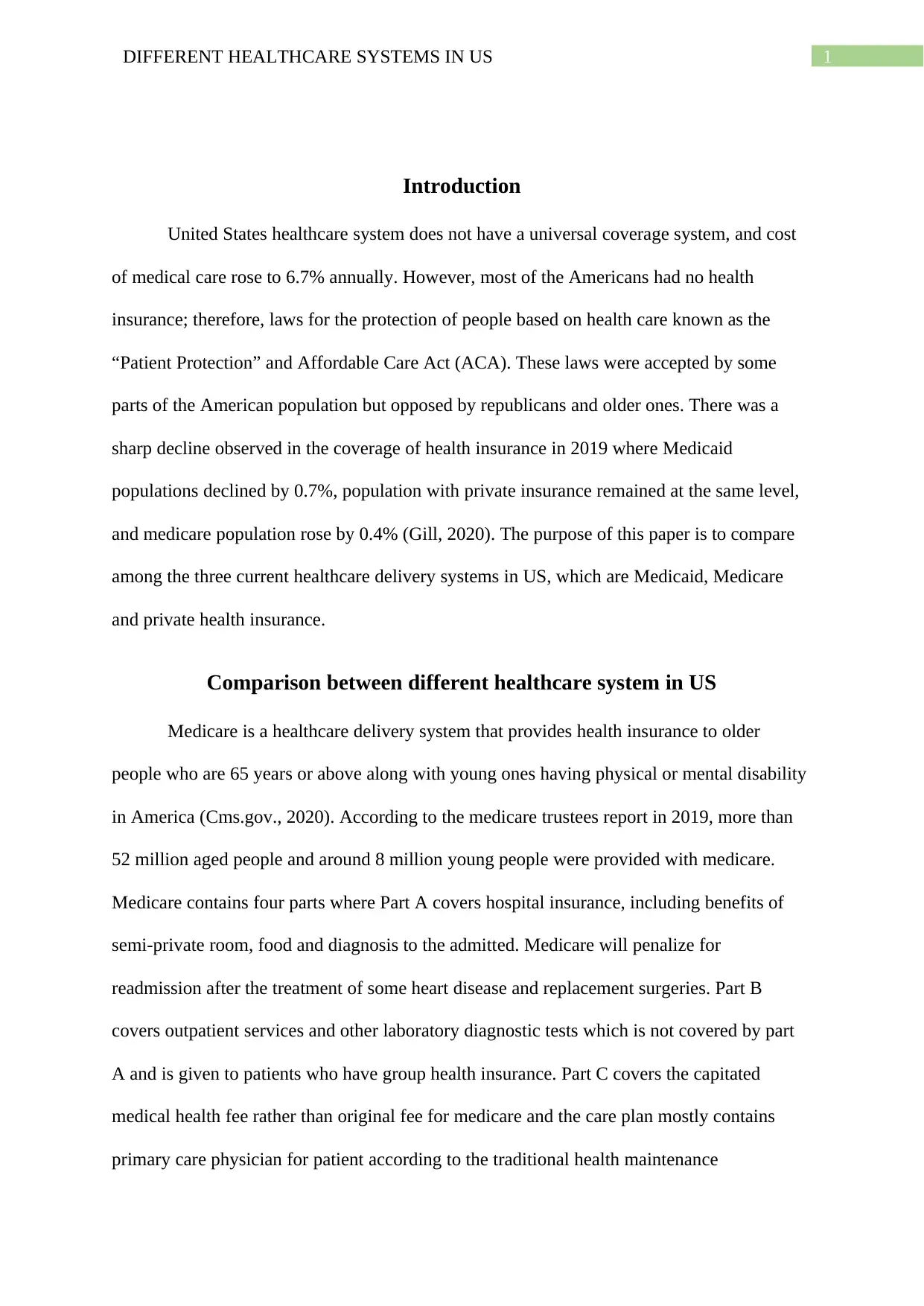
1DIFFERENT HEALTHCARE SYSTEMS IN US
Introduction
United States healthcare system does not have a universal coverage system, and cost
of medical care rose to 6.7% annually. However, most of the Americans had no health
insurance; therefore, laws for the protection of people based on health care known as the
“Patient Protection” and Affordable Care Act (ACA). These laws were accepted by some
parts of the American population but opposed by republicans and older ones. There was a
sharp decline observed in the coverage of health insurance in 2019 where Medicaid
populations declined by 0.7%, population with private insurance remained at the same level,
and medicare population rose by 0.4% (Gill, 2020). The purpose of this paper is to compare
among the three current healthcare delivery systems in US, which are Medicaid, Medicare
and private health insurance.
Comparison between different healthcare system in US
Medicare is a healthcare delivery system that provides health insurance to older
people who are 65 years or above along with young ones having physical or mental disability
in America (Cms.gov., 2020). According to the medicare trustees report in 2019, more than
52 million aged people and around 8 million young people were provided with medicare.
Medicare contains four parts where Part A covers hospital insurance, including benefits of
semi-private room, food and diagnosis to the admitted. Medicare will penalize for
readmission after the treatment of some heart disease and replacement surgeries. Part B
covers outpatient services and other laboratory diagnostic tests which is not covered by part
A and is given to patients who have group health insurance. Part C covers the capitated
medical health fee rather than original fee for medicare and the care plan mostly contains
primary care physician for patient according to the traditional health maintenance
Introduction
United States healthcare system does not have a universal coverage system, and cost
of medical care rose to 6.7% annually. However, most of the Americans had no health
insurance; therefore, laws for the protection of people based on health care known as the
“Patient Protection” and Affordable Care Act (ACA). These laws were accepted by some
parts of the American population but opposed by republicans and older ones. There was a
sharp decline observed in the coverage of health insurance in 2019 where Medicaid
populations declined by 0.7%, population with private insurance remained at the same level,
and medicare population rose by 0.4% (Gill, 2020). The purpose of this paper is to compare
among the three current healthcare delivery systems in US, which are Medicaid, Medicare
and private health insurance.
Comparison between different healthcare system in US
Medicare is a healthcare delivery system that provides health insurance to older
people who are 65 years or above along with young ones having physical or mental disability
in America (Cms.gov., 2020). According to the medicare trustees report in 2019, more than
52 million aged people and around 8 million young people were provided with medicare.
Medicare contains four parts where Part A covers hospital insurance, including benefits of
semi-private room, food and diagnosis to the admitted. Medicare will penalize for
readmission after the treatment of some heart disease and replacement surgeries. Part B
covers outpatient services and other laboratory diagnostic tests which is not covered by part
A and is given to patients who have group health insurance. Part C covers the capitated
medical health fee rather than original fee for medicare and the care plan mostly contains
primary care physician for patient according to the traditional health maintenance
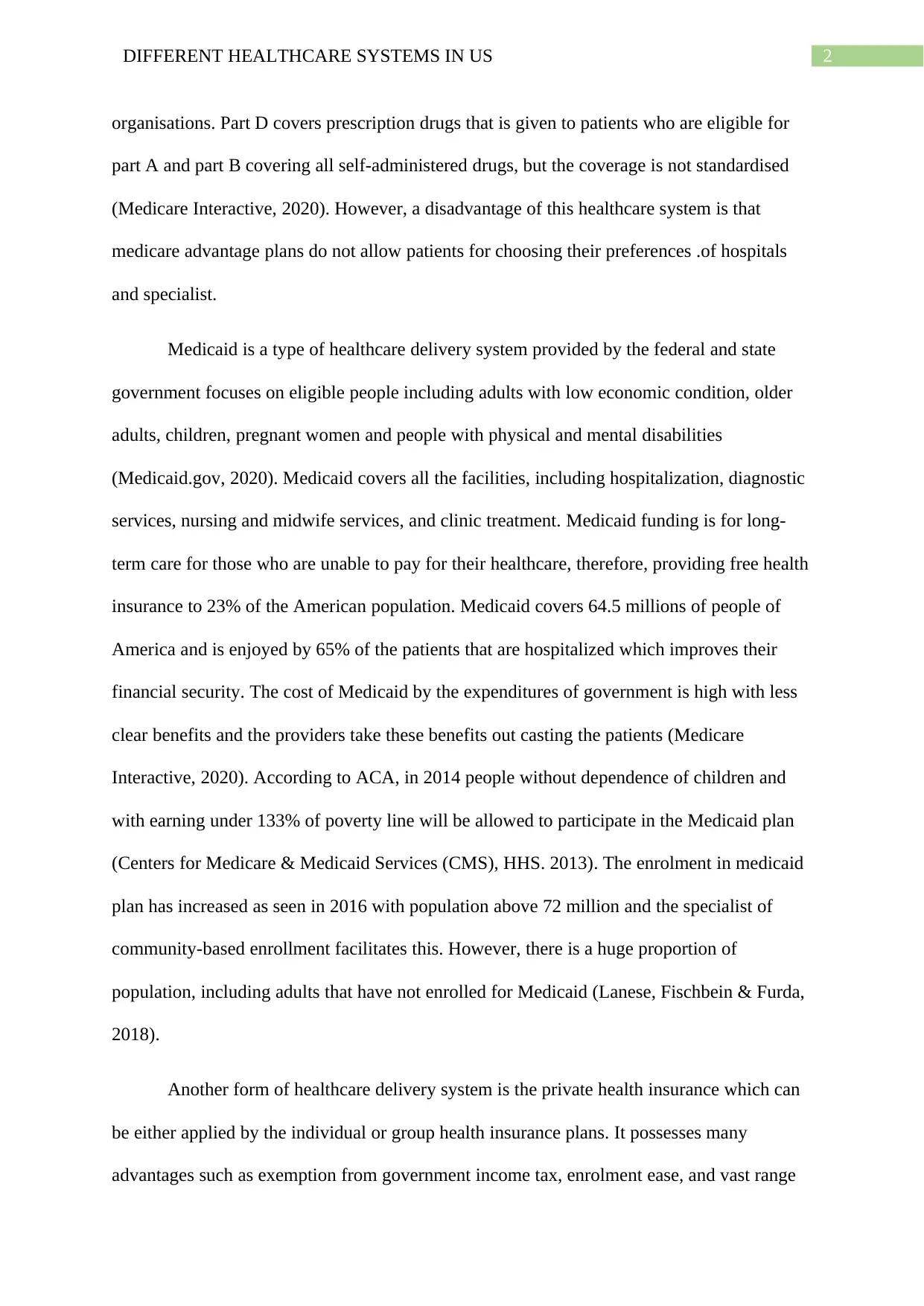
2DIFFERENT HEALTHCARE SYSTEMS IN US
organisations. Part D covers prescription drugs that is given to patients who are eligible for
part A and part B covering all self-administered drugs, but the coverage is not standardised
(Medicare Interactive, 2020). However, a disadvantage of this healthcare system is that
medicare advantage plans do not allow patients for choosing their preferences .of hospitals
and specialist.
Medicaid is a type of healthcare delivery system provided by the federal and state
government focuses on eligible people including adults with low economic condition, older
adults, children, pregnant women and people with physical and mental disabilities
(Medicaid.gov, 2020). Medicaid covers all the facilities, including hospitalization, diagnostic
services, nursing and midwife services, and clinic treatment. Medicaid funding is for long-
term care for those who are unable to pay for their healthcare, therefore, providing free health
insurance to 23% of the American population. Medicaid covers 64.5 millions of people of
America and is enjoyed by 65% of the patients that are hospitalized which improves their
financial security. The cost of Medicaid by the expenditures of government is high with less
clear benefits and the providers take these benefits out casting the patients (Medicare
Interactive, 2020). According to ACA, in 2014 people without dependence of children and
with earning under 133% of poverty line will be allowed to participate in the Medicaid plan
(Centers for Medicare & Medicaid Services (CMS), HHS. 2013). The enrolment in medicaid
plan has increased as seen in 2016 with population above 72 million and the specialist of
community-based enrollment facilitates this. However, there is a huge proportion of
population, including adults that have not enrolled for Medicaid (Lanese, Fischbein & Furda,
2018).
Another form of healthcare delivery system is the private health insurance which can
be either applied by the individual or group health insurance plans. It possesses many
advantages such as exemption from government income tax, enrolment ease, and vast range
organisations. Part D covers prescription drugs that is given to patients who are eligible for
part A and part B covering all self-administered drugs, but the coverage is not standardised
(Medicare Interactive, 2020). However, a disadvantage of this healthcare system is that
medicare advantage plans do not allow patients for choosing their preferences .of hospitals
and specialist.
Medicaid is a type of healthcare delivery system provided by the federal and state
government focuses on eligible people including adults with low economic condition, older
adults, children, pregnant women and people with physical and mental disabilities
(Medicaid.gov, 2020). Medicaid covers all the facilities, including hospitalization, diagnostic
services, nursing and midwife services, and clinic treatment. Medicaid funding is for long-
term care for those who are unable to pay for their healthcare, therefore, providing free health
insurance to 23% of the American population. Medicaid covers 64.5 millions of people of
America and is enjoyed by 65% of the patients that are hospitalized which improves their
financial security. The cost of Medicaid by the expenditures of government is high with less
clear benefits and the providers take these benefits out casting the patients (Medicare
Interactive, 2020). According to ACA, in 2014 people without dependence of children and
with earning under 133% of poverty line will be allowed to participate in the Medicaid plan
(Centers for Medicare & Medicaid Services (CMS), HHS. 2013). The enrolment in medicaid
plan has increased as seen in 2016 with population above 72 million and the specialist of
community-based enrollment facilitates this. However, there is a huge proportion of
population, including adults that have not enrolled for Medicaid (Lanese, Fischbein & Furda,
2018).
Another form of healthcare delivery system is the private health insurance which can
be either applied by the individual or group health insurance plans. It possesses many
advantages such as exemption from government income tax, enrolment ease, and vast range
⊘ This is a preview!⊘
Do you want full access?
Subscribe today to unlock all pages.

Trusted by 1+ million students worldwide
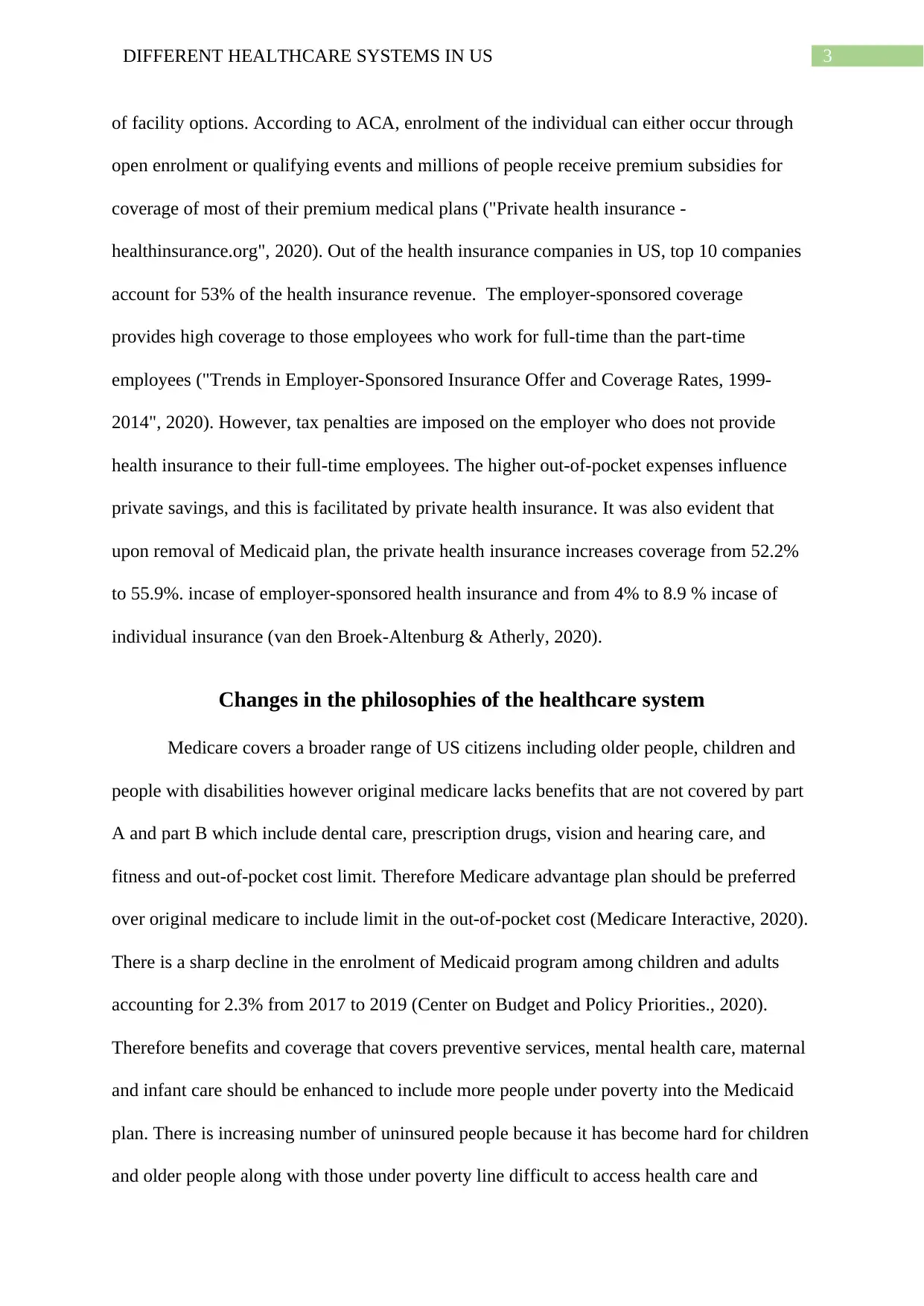
3DIFFERENT HEALTHCARE SYSTEMS IN US
of facility options. According to ACA, enrolment of the individual can either occur through
open enrolment or qualifying events and millions of people receive premium subsidies for
coverage of most of their premium medical plans ("Private health insurance -
healthinsurance.org", 2020). Out of the health insurance companies in US, top 10 companies
account for 53% of the health insurance revenue. The employer-sponsored coverage
provides high coverage to those employees who work for full-time than the part-time
employees ("Trends in Employer-Sponsored Insurance Offer and Coverage Rates, 1999-
2014", 2020). However, tax penalties are imposed on the employer who does not provide
health insurance to their full-time employees. The higher out-of-pocket expenses influence
private savings, and this is facilitated by private health insurance. It was also evident that
upon removal of Medicaid plan, the private health insurance increases coverage from 52.2%
to 55.9%. incase of employer-sponsored health insurance and from 4% to 8.9 % incase of
individual insurance (van den Broek-Altenburg & Atherly, 2020).
Changes in the philosophies of the healthcare system
Medicare covers a broader range of US citizens including older people, children and
people with disabilities however original medicare lacks benefits that are not covered by part
A and part B which include dental care, prescription drugs, vision and hearing care, and
fitness and out-of-pocket cost limit. Therefore Medicare advantage plan should be preferred
over original medicare to include limit in the out-of-pocket cost (Medicare Interactive, 2020).
There is a sharp decline in the enrolment of Medicaid program among children and adults
accounting for 2.3% from 2017 to 2019 (Center on Budget and Policy Priorities., 2020).
Therefore benefits and coverage that covers preventive services, mental health care, maternal
and infant care should be enhanced to include more people under poverty into the Medicaid
plan. There is increasing number of uninsured people because it has become hard for children
and older people along with those under poverty line difficult to access health care and
of facility options. According to ACA, enrolment of the individual can either occur through
open enrolment or qualifying events and millions of people receive premium subsidies for
coverage of most of their premium medical plans ("Private health insurance -
healthinsurance.org", 2020). Out of the health insurance companies in US, top 10 companies
account for 53% of the health insurance revenue. The employer-sponsored coverage
provides high coverage to those employees who work for full-time than the part-time
employees ("Trends in Employer-Sponsored Insurance Offer and Coverage Rates, 1999-
2014", 2020). However, tax penalties are imposed on the employer who does not provide
health insurance to their full-time employees. The higher out-of-pocket expenses influence
private savings, and this is facilitated by private health insurance. It was also evident that
upon removal of Medicaid plan, the private health insurance increases coverage from 52.2%
to 55.9%. incase of employer-sponsored health insurance and from 4% to 8.9 % incase of
individual insurance (van den Broek-Altenburg & Atherly, 2020).
Changes in the philosophies of the healthcare system
Medicare covers a broader range of US citizens including older people, children and
people with disabilities however original medicare lacks benefits that are not covered by part
A and part B which include dental care, prescription drugs, vision and hearing care, and
fitness and out-of-pocket cost limit. Therefore Medicare advantage plan should be preferred
over original medicare to include limit in the out-of-pocket cost (Medicare Interactive, 2020).
There is a sharp decline in the enrolment of Medicaid program among children and adults
accounting for 2.3% from 2017 to 2019 (Center on Budget and Policy Priorities., 2020).
Therefore benefits and coverage that covers preventive services, mental health care, maternal
and infant care should be enhanced to include more people under poverty into the Medicaid
plan. There is increasing number of uninsured people because it has become hard for children
and older people along with those under poverty line difficult to access health care and
Paraphrase This Document
Need a fresh take? Get an instant paraphrase of this document with our AI Paraphraser
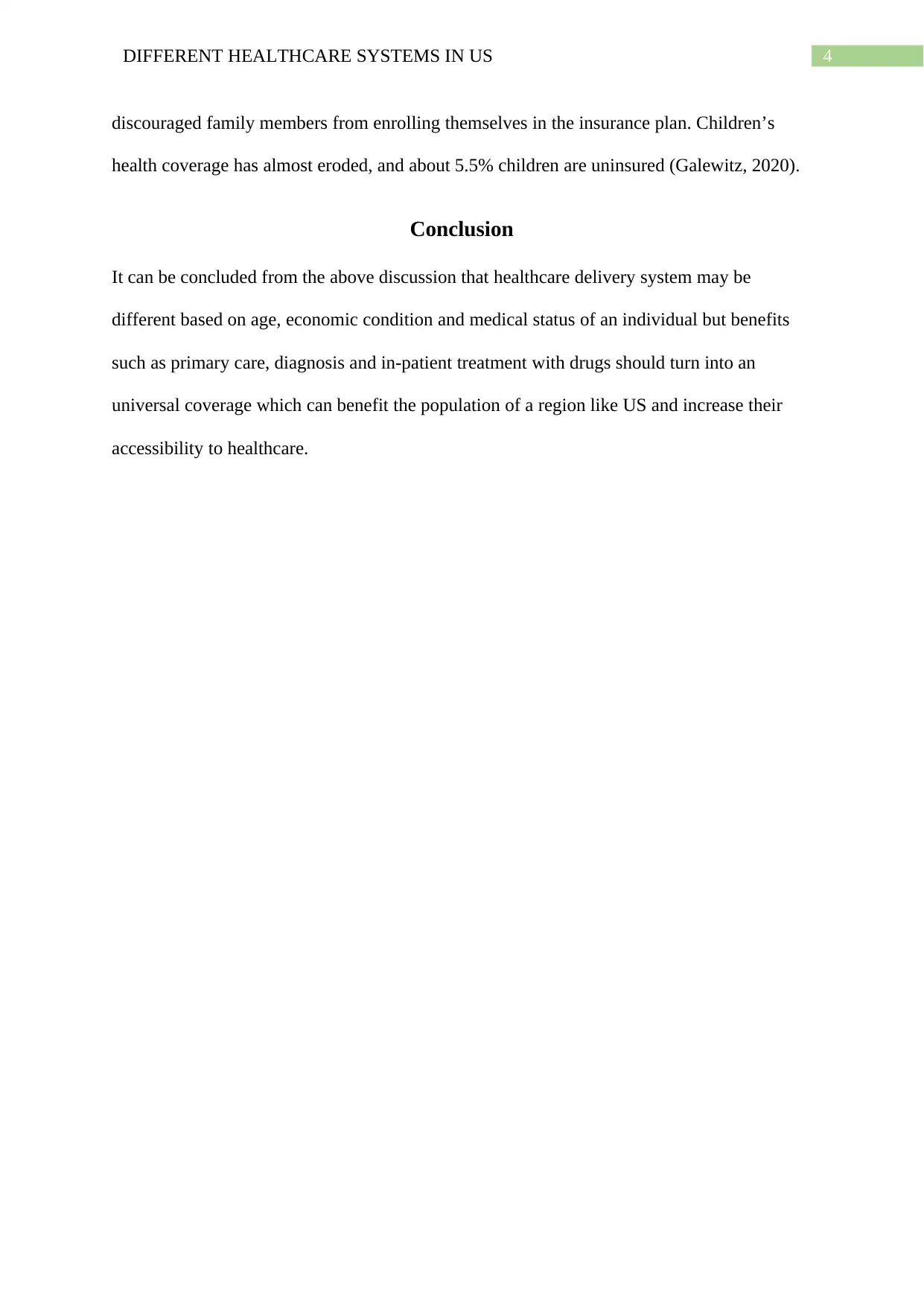
4DIFFERENT HEALTHCARE SYSTEMS IN US
discouraged family members from enrolling themselves in the insurance plan. Children’s
health coverage has almost eroded, and about 5.5% children are uninsured (Galewitz, 2020).
Conclusion
It can be concluded from the above discussion that healthcare delivery system may be
different based on age, economic condition and medical status of an individual but benefits
such as primary care, diagnosis and in-patient treatment with drugs should turn into an
universal coverage which can benefit the population of a region like US and increase their
accessibility to healthcare.
discouraged family members from enrolling themselves in the insurance plan. Children’s
health coverage has almost eroded, and about 5.5% children are uninsured (Galewitz, 2020).
Conclusion
It can be concluded from the above discussion that healthcare delivery system may be
different based on age, economic condition and medical status of an individual but benefits
such as primary care, diagnosis and in-patient treatment with drugs should turn into an
universal coverage which can benefit the population of a region like US and increase their
accessibility to healthcare.
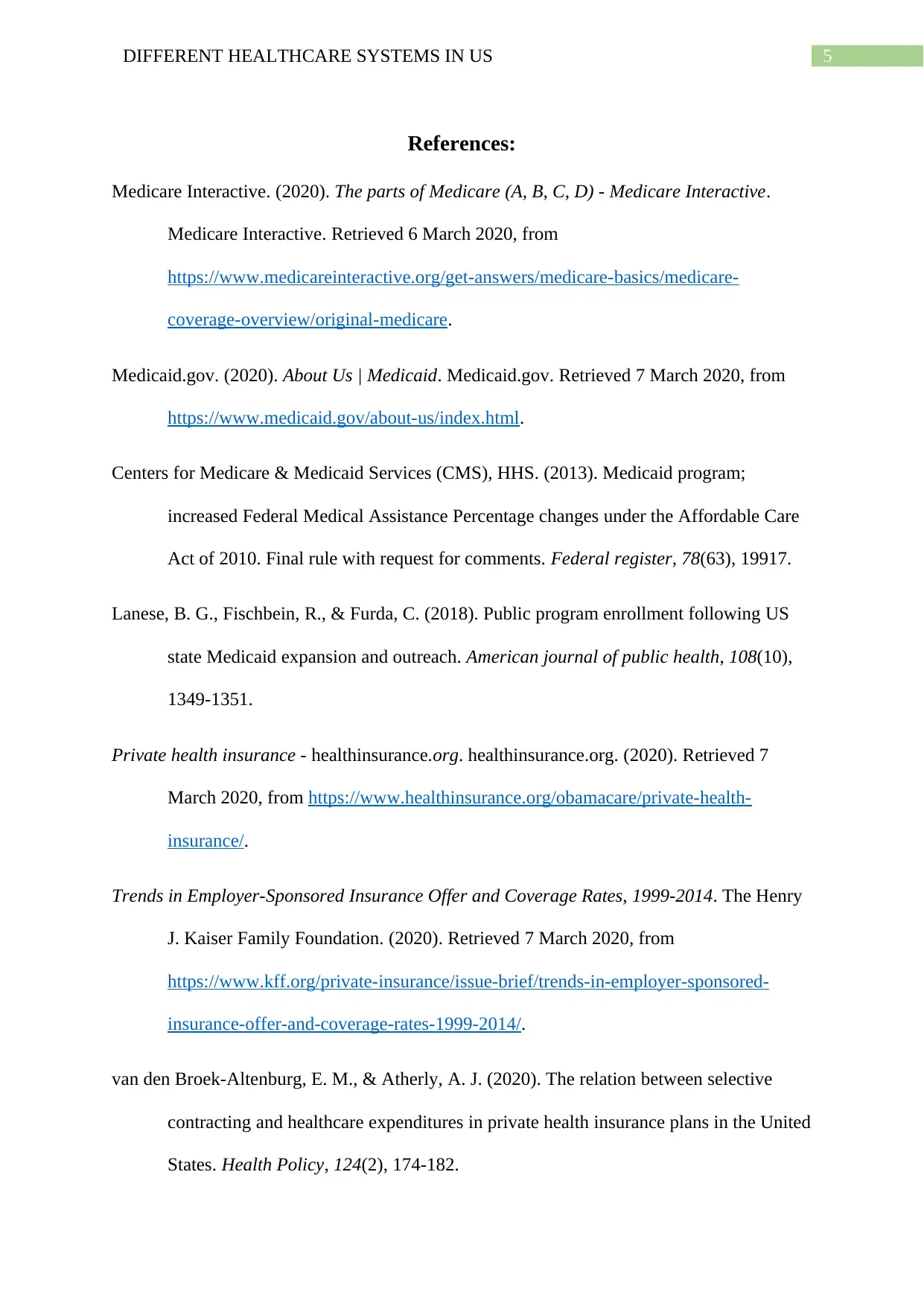
5DIFFERENT HEALTHCARE SYSTEMS IN US
References:
Medicare Interactive. (2020). The parts of Medicare (A, B, C, D) - Medicare Interactive.
Medicare Interactive. Retrieved 6 March 2020, from
https://www.medicareinteractive.org/get-answers/medicare-basics/medicare-
coverage-overview/original-medicare.
Medicaid.gov. (2020). About Us | Medicaid. Medicaid.gov. Retrieved 7 March 2020, from
https://www.medicaid.gov/about-us/index.html.
Centers for Medicare & Medicaid Services (CMS), HHS. (2013). Medicaid program;
increased Federal Medical Assistance Percentage changes under the Affordable Care
Act of 2010. Final rule with request for comments. Federal register, 78(63), 19917.
Lanese, B. G., Fischbein, R., & Furda, C. (2018). Public program enrollment following US
state Medicaid expansion and outreach. American journal of public health, 108(10),
1349-1351.
Private health insurance - healthinsurance.org. healthinsurance.org. (2020). Retrieved 7
March 2020, from https://www.healthinsurance.org/obamacare/private-health-
insurance/.
Trends in Employer-Sponsored Insurance Offer and Coverage Rates, 1999-2014. The Henry
J. Kaiser Family Foundation. (2020). Retrieved 7 March 2020, from
https://www.kff.org/private-insurance/issue-brief/trends-in-employer-sponsored-
insurance-offer-and-coverage-rates-1999-2014/.
van den Broek-Altenburg, E. M., & Atherly, A. J. (2020). The relation between selective
contracting and healthcare expenditures in private health insurance plans in the United
States. Health Policy, 124(2), 174-182.
References:
Medicare Interactive. (2020). The parts of Medicare (A, B, C, D) - Medicare Interactive.
Medicare Interactive. Retrieved 6 March 2020, from
https://www.medicareinteractive.org/get-answers/medicare-basics/medicare-
coverage-overview/original-medicare.
Medicaid.gov. (2020). About Us | Medicaid. Medicaid.gov. Retrieved 7 March 2020, from
https://www.medicaid.gov/about-us/index.html.
Centers for Medicare & Medicaid Services (CMS), HHS. (2013). Medicaid program;
increased Federal Medical Assistance Percentage changes under the Affordable Care
Act of 2010. Final rule with request for comments. Federal register, 78(63), 19917.
Lanese, B. G., Fischbein, R., & Furda, C. (2018). Public program enrollment following US
state Medicaid expansion and outreach. American journal of public health, 108(10),
1349-1351.
Private health insurance - healthinsurance.org. healthinsurance.org. (2020). Retrieved 7
March 2020, from https://www.healthinsurance.org/obamacare/private-health-
insurance/.
Trends in Employer-Sponsored Insurance Offer and Coverage Rates, 1999-2014. The Henry
J. Kaiser Family Foundation. (2020). Retrieved 7 March 2020, from
https://www.kff.org/private-insurance/issue-brief/trends-in-employer-sponsored-
insurance-offer-and-coverage-rates-1999-2014/.
van den Broek-Altenburg, E. M., & Atherly, A. J. (2020). The relation between selective
contracting and healthcare expenditures in private health insurance plans in the United
States. Health Policy, 124(2), 174-182.
⊘ This is a preview!⊘
Do you want full access?
Subscribe today to unlock all pages.

Trusted by 1+ million students worldwide
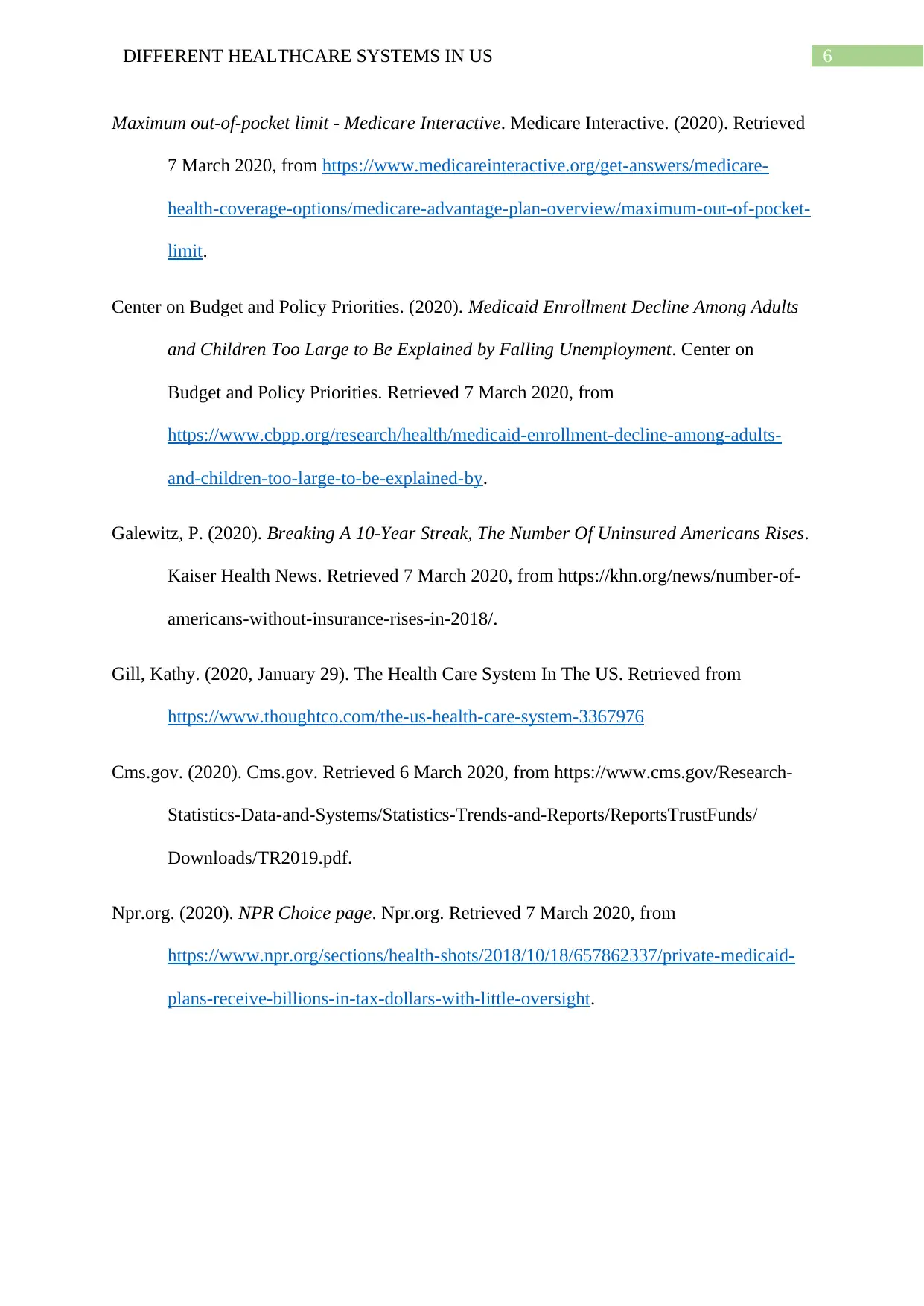
6DIFFERENT HEALTHCARE SYSTEMS IN US
Maximum out-of-pocket limit - Medicare Interactive. Medicare Interactive. (2020). Retrieved
7 March 2020, from https://www.medicareinteractive.org/get-answers/medicare-
health-coverage-options/medicare-advantage-plan-overview/maximum-out-of-pocket-
limit.
Center on Budget and Policy Priorities. (2020). Medicaid Enrollment Decline Among Adults
and Children Too Large to Be Explained by Falling Unemployment. Center on
Budget and Policy Priorities. Retrieved 7 March 2020, from
https://www.cbpp.org/research/health/medicaid-enrollment-decline-among-adults-
and-children-too-large-to-be-explained-by.
Galewitz, P. (2020). Breaking A 10-Year Streak, The Number Of Uninsured Americans Rises.
Kaiser Health News. Retrieved 7 March 2020, from https://khn.org/news/number-of-
americans-without-insurance-rises-in-2018/.
Gill, Kathy. (2020, January 29). The Health Care System In The US. Retrieved from
https://www.thoughtco.com/the-us-health-care-system-3367976
Cms.gov. (2020). Cms.gov. Retrieved 6 March 2020, from https://www.cms.gov/Research-
Statistics-Data-and-Systems/Statistics-Trends-and-Reports/ReportsTrustFunds/
Downloads/TR2019.pdf.
Npr.org. (2020). NPR Choice page. Npr.org. Retrieved 7 March 2020, from
https://www.npr.org/sections/health-shots/2018/10/18/657862337/private-medicaid-
plans-receive-billions-in-tax-dollars-with-little-oversight.
Maximum out-of-pocket limit - Medicare Interactive. Medicare Interactive. (2020). Retrieved
7 March 2020, from https://www.medicareinteractive.org/get-answers/medicare-
health-coverage-options/medicare-advantage-plan-overview/maximum-out-of-pocket-
limit.
Center on Budget and Policy Priorities. (2020). Medicaid Enrollment Decline Among Adults
and Children Too Large to Be Explained by Falling Unemployment. Center on
Budget and Policy Priorities. Retrieved 7 March 2020, from
https://www.cbpp.org/research/health/medicaid-enrollment-decline-among-adults-
and-children-too-large-to-be-explained-by.
Galewitz, P. (2020). Breaking A 10-Year Streak, The Number Of Uninsured Americans Rises.
Kaiser Health News. Retrieved 7 March 2020, from https://khn.org/news/number-of-
americans-without-insurance-rises-in-2018/.
Gill, Kathy. (2020, January 29). The Health Care System In The US. Retrieved from
https://www.thoughtco.com/the-us-health-care-system-3367976
Cms.gov. (2020). Cms.gov. Retrieved 6 March 2020, from https://www.cms.gov/Research-
Statistics-Data-and-Systems/Statistics-Trends-and-Reports/ReportsTrustFunds/
Downloads/TR2019.pdf.
Npr.org. (2020). NPR Choice page. Npr.org. Retrieved 7 March 2020, from
https://www.npr.org/sections/health-shots/2018/10/18/657862337/private-medicaid-
plans-receive-billions-in-tax-dollars-with-little-oversight.
1 out of 7
Related Documents
Your All-in-One AI-Powered Toolkit for Academic Success.
+13062052269
info@desklib.com
Available 24*7 on WhatsApp / Email
![[object Object]](/_next/static/media/star-bottom.7253800d.svg)
Unlock your academic potential
Copyright © 2020–2025 A2Z Services. All Rights Reserved. Developed and managed by ZUCOL.





